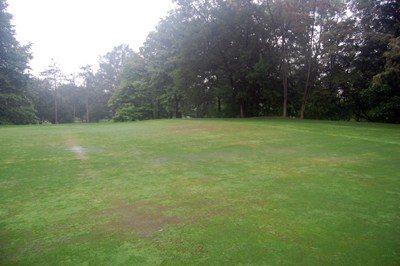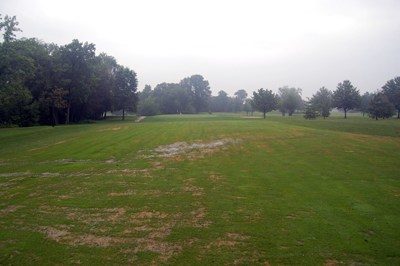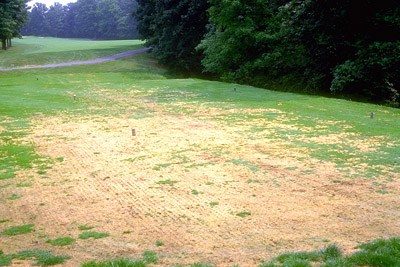Anaerobic Soils: Too Much of a Good Thing Not
Always Good For Turf
In many parts of the United States conditions have been hot and dry with some areas under severe drought conditions. However, in some parts of the country excessive rain during hot humid weather has resulted in rapid turf loss.
Soils are comprised of mineral (sand, silt, clay), water and air. Oxygen or the air component, which comprises 25 percent of soil, is important in root respiration. Respiration is the process where sugars and starches are converted into energy primarily ATP, carbon dioxide and water.
Respiration requires oxygen and the process itself is an oxidation process. Oxygen is important in aerobic respiration because it is the final electron acceptor in the energy releasing pathway known as electron transfer. If oxygen is not present or at a low level, which would be the case in an anaerobic soil the energy released would be roughly 1/18th of the potential.
Without energy new root cells and tissue are not produced, and water and nutrient uptake limited. In combination with warm summertime temperatures root death can occur within hours under anaerobic conditions.
Symptoms caused by anaerobic conditions may initially appear as a yellowing of the turf due to the inability of the plants to absorb nutrients. The plants will start to wilt and decline due to the inability of the roots to absorb water. Symptoms are most severe on compacted poorly drained soils with a turf that is shallow rooted.
Practices that improve water movement through the soil like internal and surface drainage, air movement, and alleviating soil compaction like coring are important in improving oxygen levels in the soil.
Soils are comprised of mineral (sand, silt, clay), water and air. Oxygen or the air component, which comprises 25 percent of soil, is important in root respiration. Respiration is the process where sugars and starches are converted into energy primarily ATP, carbon dioxide and water.
Respiration requires oxygen and the process itself is an oxidation process. Oxygen is important in aerobic respiration because it is the final electron acceptor in the energy releasing pathway known as electron transfer. If oxygen is not present or at a low level, which would be the case in an anaerobic soil the energy released would be roughly 1/18th of the potential.
Without energy new root cells and tissue are not produced, and water and nutrient uptake limited. In combination with warm summertime temperatures root death can occur within hours under anaerobic conditions.
Symptoms caused by anaerobic conditions may initially appear as a yellowing of the turf due to the inability of the plants to absorb nutrients. The plants will start to wilt and decline due to the inability of the roots to absorb water. Symptoms are most severe on compacted poorly drained soils with a turf that is shallow rooted.
Practices that improve water movement through the soil like internal and surface drainage, air movement, and alleviating soil compaction like coring are important in improving oxygen levels in the soil.


Photo 1 & 2:
A common term used to describe turf loss due to anaerobic soil conditions is wet wilt. The turf actually wilts be-cause of the inability to take up water although water is present in excessive amounts. Water uptake is an active process that takes energy.

Photo 3:
Conditions where anaerobic conditions can develop are low lying areas with little air movement. Normally on soils that are compacted and shallow turf root symptoms.
